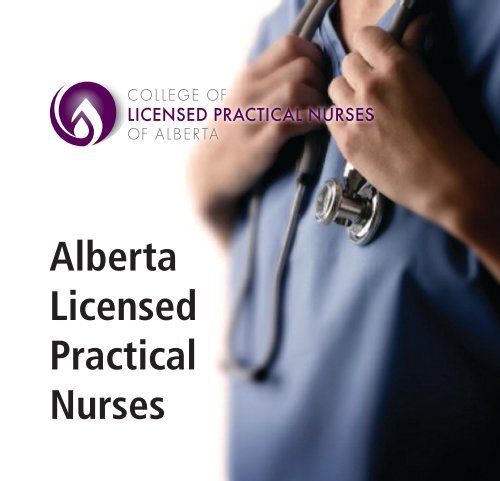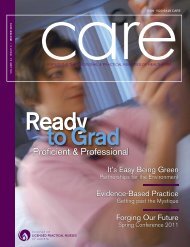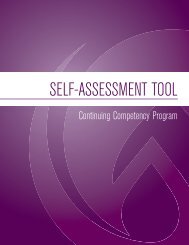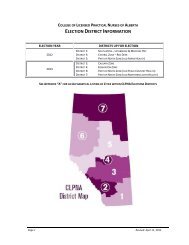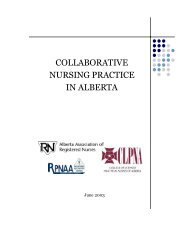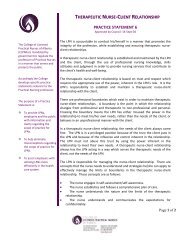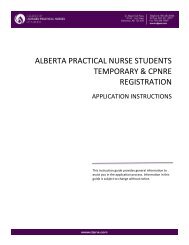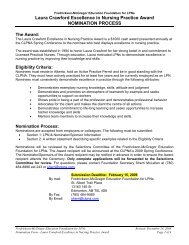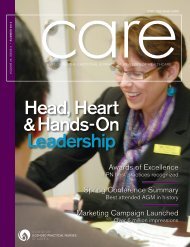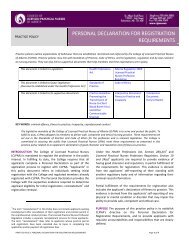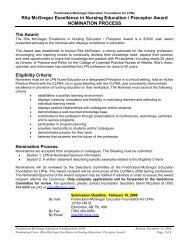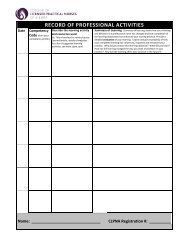Competency Profile Outline - College of Licensed Practical Nurses ...
Competency Profile Outline - College of Licensed Practical Nurses ...
Competency Profile Outline - College of Licensed Practical Nurses ...
Create successful ePaper yourself
Turn your PDF publications into a flip-book with our unique Google optimized e-Paper software.
Alberta<br />
<strong>Licensed</strong><br />
<strong>Practical</strong><br />
<strong>Nurses</strong>
ALBERTA LICENSED PRACTICAL NURSES<br />
<strong>Licensed</strong> <strong>Practical</strong> <strong>Nurses</strong> (LPNs) have been in practice in the province <strong>of</strong> Alberta for over<br />
60 years. Education and clinical practice for the LPN pr<strong>of</strong>ession has evolved, enhancing<br />
the opportunities for LPN practice. These comprehensive changes to basic education, continuing<br />
education, and practice environments have impacted the demand for LPNs and<br />
opened new and unique opportunities throughout the province.<br />
WHO IS AN LPN?<br />
LPNs are pr<strong>of</strong>essional nurses and work within their own scope <strong>of</strong> practice, standards <strong>of</strong><br />
practice, and code <strong>of</strong> ethics. LPNs are one <strong>of</strong> three categories <strong>of</strong> pr<strong>of</strong>essional nurses in Alberta<br />
and continue to excel as frontline nurses involved in the assessment, planning, implementation,<br />
and evaluation <strong>of</strong> nursing care.<br />
LPNs study from the same body <strong>of</strong> nursing knowledge as registered nurses (RNs) and registered<br />
psychiatric nurses (RPNs) with a more focused approach in<br />
foundational knowledge, critical thinking, and clinical<br />
judgment to suit the LPN role <strong>of</strong> today. LPNs<br />
have the knowledge, skill, judgment, and abilities<br />
to contribute in all phases <strong>of</strong> the continuum <strong>of</strong> care<br />
from prevention to acute treatment and management,<br />
to long term and palliative care. LPNs may<br />
have independent, interdependent, and <strong>of</strong>ten overlapping<br />
roles on the health care team.
EDUCATION<br />
LPNs in Alberta graduate from a two year diploma in practical nursing <strong>of</strong>fered at the college<br />
level. The program provides a minimum <strong>of</strong> 1650 instructional hours including 750<br />
hours <strong>of</strong> theoretical instruction and 900 hours <strong>of</strong> clinical / lab experience.<br />
There are numerous post-basic learning opportunities for LPNs. Specialty education is available<br />
in many areas such as: immunization, operating room, advanced orthopedics, and<br />
renal dialysis.There are also additional certificate programs in areas such as: mental health,<br />
chronic disease management, leadership, gerontology, wound care, palliative care, and<br />
foot care.<br />
ROLE & SCOPE OF PRACTICE<br />
LPNs in Alberta practice autonomously and assume full responsibility for their own practice.<br />
As trusted and respected pr<strong>of</strong>essional nurses, LPNs serve individuals, families, and<br />
groups, assessing their needs and providing care and treatments as appropriate.<br />
LPNs are accountable for their own nursing practice and as any pr<strong>of</strong>essional, are expected<br />
to seek assistance when the needs within their practice go beyond their competence level.<br />
There are many roles within Alberta for LPNs in areas such as: acute care, long term care,<br />
community, primary care clinics, education, occupational health and safety, public health,<br />
and leadership.<br />
LPNs advocate for clients related to all areas <strong>of</strong> practice including human, physical, and financial<br />
resources necessary to provide safe, quality nursing care. LPN work collaboratively<br />
with clients, families, and the health care team to ensure continuity <strong>of</strong> care and quality<br />
health service delivery.
REGULATED PROFESSIONAL NURSES<br />
As a self-regulating pr<strong>of</strong>ession, LPNs must meet registration requirements set out by the<br />
<strong>College</strong> <strong>of</strong> LPNs <strong>of</strong> Alberta under the Health Pr<strong>of</strong>essions Act LPN Regulation (2003).This includes<br />
initial registration upon completion <strong>of</strong> an approved practical nurse program or equivalency.<br />
It also includes annual renewal <strong>of</strong> registration, participation in continuing<br />
competence activities, and being actively engaged in the practice <strong>of</strong> the pr<strong>of</strong>ession.<br />
COMPETENCY PROFILE OUTLINE FOR LPNS<br />
<strong>Competency</strong> is defined as the knowledge, skills, behaviors, and attitudes <strong>of</strong> a pr<strong>of</strong>essional.<br />
The following document outlines the Alberta LPN competencies, which define basic, additional,<br />
and specialized competencies <strong>of</strong> the LPN pr<strong>of</strong>ession. No one LPN is required to possess<br />
all competencies <strong>of</strong> the pr<strong>of</strong>ession. Each individual will possess a set <strong>of</strong> competencies<br />
specific to their own expertise, based on their work experience and practice setting. The<br />
<strong>Competency</strong> <strong>Pr<strong>of</strong>ile</strong> is a detailed account <strong>of</strong> these competencies and it is available directly<br />
from the CLPNA.
<strong>Competency</strong> <strong>Pr<strong>of</strong>ile</strong> <strong>Outline</strong><br />
for<br />
<strong>Licensed</strong> <strong>Practical</strong> <strong>Nurses</strong>
A.<br />
Nursing<br />
Knowledge<br />
A-1<br />
Anatomy and<br />
Physiology<br />
A-2<br />
Microbiology<br />
A-3<br />
Pathophysiology<br />
A-4<br />
Medical<br />
Terminology<br />
A-5<br />
Growth and<br />
Development<br />
A-6<br />
Nutrition<br />
A-7<br />
Pharmacology<br />
A-8<br />
Nursing Science<br />
A-9<br />
Communication<br />
B.<br />
Nursing<br />
Process<br />
B-1<br />
Assessment<br />
B-2<br />
Planning<br />
B-3<br />
Implementation<br />
B-4<br />
Evaluation<br />
C.<br />
Safety C-1<br />
Fire emergency<br />
C-2<br />
Disaster<br />
emergency<br />
C-3<br />
Bomb threat<br />
C-4<br />
Missing client<br />
C-5<br />
Personal<br />
protection<br />
devices<br />
C-6<br />
Standard<br />
precautions<br />
C-7<br />
Infection control<br />
C-8<br />
Handling and<br />
disposal <strong>of</strong><br />
sharps<br />
C-9<br />
WHMIS and<br />
transportation <strong>of</strong><br />
dangerous goods<br />
C-10<br />
Handling <strong>of</strong> biomedical<br />
waste<br />
C-11<br />
Refusal <strong>of</strong><br />
treatment<br />
C-12<br />
Maintain physical<br />
safety <strong>of</strong> client<br />
C-13<br />
Safe work<br />
practices<br />
C-14<br />
Safety reports<br />
and<br />
documentation<br />
D.<br />
Communication<br />
and<br />
Interpersonal<br />
Skills<br />
D-1<br />
Effective<br />
communication<br />
D-2<br />
Therapeutic<br />
nurse-client<br />
relationship<br />
D-3<br />
Functioning as an<br />
effective team<br />
leader<br />
D-4<br />
Client and family<br />
teaching<br />
D-5<br />
Legal protocols,<br />
documenting and<br />
reporting<br />
D-6<br />
Accept,<br />
transcribe and<br />
initiate orders<br />
D-7<br />
Conflict<br />
management<br />
D-8<br />
Time<br />
management<br />
E. Nursing<br />
Practice<br />
E-1<br />
Critical thinking<br />
E-2<br />
Clinical judgment<br />
and decision<br />
making<br />
E-3<br />
CPR and code<br />
procedure<br />
E-4<br />
Admission<br />
procedures<br />
E-5<br />
Nursing diagnosis<br />
E-6<br />
Client transfer,<br />
discharge and<br />
referral<br />
E-7<br />
Activities <strong>of</strong> daily<br />
living<br />
E-8<br />
Mobility <strong>of</strong> clients<br />
E-9<br />
Nutrition/<br />
hydration<br />
E-10<br />
Elimination<br />
E-11<br />
Medical/surgical<br />
asepsis<br />
E-12<br />
Peritoneal<br />
dialysis<br />
E-13<br />
Foot care<br />
E-14<br />
Wound care<br />
E-15<br />
Specimen<br />
collection and<br />
testing<br />
E-16<br />
Resource<br />
utilization<br />
E-17<br />
Post modern care
F.<br />
Respiratory<br />
Care<br />
F-1<br />
Airway<br />
management<br />
F-2<br />
Oxygen therapy<br />
F-3<br />
Suctioning<br />
F-4<br />
Respiratory<br />
treatments<br />
F-5<br />
Tracheostomy<br />
care<br />
F-6<br />
Chest tubes<br />
G.<br />
Surgical<br />
Nursing<br />
G-1<br />
Knowledge <strong>of</strong><br />
surgical<br />
procedures<br />
G-2<br />
Perioperative<br />
teaching<br />
G-3<br />
Pre-operative<br />
care<br />
G-4<br />
Post-operative<br />
care<br />
G-5<br />
Wounds, tubing<br />
and drains<br />
G-6<br />
Removal <strong>of</strong><br />
staples and<br />
sutures<br />
H.<br />
Orthopedic<br />
Nursing<br />
H-1<br />
Knowledge <strong>of</strong><br />
orthopedic<br />
nursing<br />
H-2<br />
Cast care<br />
H-3<br />
Traction and<br />
external fixators<br />
H-4<br />
Splints and<br />
braces<br />
I.<br />
Neurological/<br />
Neurovascular<br />
Nursing<br />
I-1<br />
Neurological/<br />
neurovascular<br />
assessment<br />
I-2<br />
Seizures<br />
I-3<br />
Spinal<br />
precautions<br />
I-4<br />
Support to the<br />
client/family<br />
J.<br />
Cardiovascular<br />
Nursing<br />
J-1 Knowledge <strong>of</strong><br />
cardiovascular<br />
disorders and<br />
diseases<br />
K. Maternal/<br />
Newborn<br />
Care<br />
K-1<br />
Prenatal care,<br />
assessment and<br />
teaching<br />
K-2<br />
Knowledge and<br />
assessment <strong>of</strong><br />
labour<br />
K-3<br />
Assist with<br />
managing labour<br />
K-4<br />
Assist with<br />
delivery<br />
K-5<br />
Postpartum care<br />
and teaching<br />
K-6<br />
Prenatal/ preoperative<br />
care<br />
and teaching<br />
K-7<br />
Postnatal/ postoperative<br />
care<br />
and teaching<br />
K-8<br />
Knowledge and<br />
teaching <strong>of</strong><br />
newborn care<br />
L.<br />
Pediatrics<br />
L-1 Knowledge,<br />
assessment and<br />
care <strong>of</strong> pediatric<br />
client/family<br />
L-2<br />
Interventions and<br />
safety procedures<br />
L-3<br />
Support and<br />
teaching to<br />
client/family<br />
L-4<br />
Knowledge and<br />
use <strong>of</strong> pediatric<br />
equipment<br />
M.<br />
Mental Health<br />
Nursing<br />
M-1 Knowledge<br />
and assessment<br />
<strong>of</strong> mental health<br />
and illness<br />
M-2<br />
Aggressive<br />
behaviour<br />
M-3<br />
Intolerable<br />
behaviour<br />
M-4<br />
Prevention and<br />
intervention in<br />
suicide<br />
M-5<br />
Substance abuse<br />
interventions<br />
M-6<br />
Mental health<br />
treatments and<br />
interventions<br />
M-7 Legal<br />
protocols and<br />
documentation<br />
requirements<br />
N.<br />
Emergency<br />
Nursing<br />
N-1<br />
Multi-systems<br />
assessment<br />
N-2<br />
Identify priority<br />
needs<br />
N-3<br />
Nursing<br />
interventions<br />
N-4<br />
Assist with<br />
emergency<br />
interventions<br />
N-5<br />
Knowledge <strong>of</strong><br />
equipment<br />
N-6<br />
Support and<br />
teach client/family
O.<br />
Gerontology<br />
Nursing<br />
0-1<br />
Aging process<br />
and health<br />
problems<br />
O-2<br />
Support and<br />
teaching<br />
O-3<br />
Nursing<br />
interventions<br />
O-4<br />
Assessment for<br />
appropriate<br />
placement<br />
O-5<br />
Safety<br />
procedures<br />
O-6<br />
Communications<br />
and advocacy<br />
P.<br />
Palliative<br />
Care<br />
P-1<br />
Assess<br />
physiological<br />
change<br />
P-2<br />
Pain<br />
management and<br />
symptom control<br />
P-3<br />
Psychological<br />
and emotional<br />
support<br />
P-4<br />
Care and comfort<br />
measures<br />
P-5<br />
Support services<br />
P-6<br />
Respect for the<br />
family’s rights<br />
and wishes<br />
P-7<br />
Post mortem care<br />
and<br />
documentation<br />
Q.<br />
Rehabilitation<br />
Nursing<br />
Q-1<br />
Apply the<br />
rehabilitation<br />
process<br />
Q-2 Assessment<br />
and provision <strong>of</strong><br />
rehabilitation<br />
process<br />
Q-3<br />
Support and<br />
teaching<br />
Q-4<br />
Collaboration<br />
Q-5<br />
Discharge<br />
planning<br />
R.<br />
Community<br />
Health<br />
R-1<br />
Knowledge <strong>of</strong><br />
community health<br />
R-2<br />
Nursing process<br />
and community<br />
health<br />
R-3<br />
Client services<br />
R-4<br />
Primary health<br />
care<br />
R-5<br />
Community<br />
health<br />
R-6<br />
Preventative<br />
health<br />
R-7<br />
Health teaching<br />
S.<br />
Clinic Based<br />
Nursing<br />
S-1<br />
Knowledge <strong>of</strong><br />
clinic based<br />
nursing<br />
S-2<br />
Assessment and<br />
prioritizing <strong>of</strong><br />
client needs<br />
S-3<br />
Nursing<br />
interventions<br />
S-4<br />
Coordinate client<br />
referral<br />
S-5<br />
Support and<br />
teaching<br />
S-6 HPA<br />
authorization to<br />
perform ear<br />
syringing<br />
S-7<br />
Ear syringing<br />
T. Occupation<br />
Health and<br />
Safety<br />
T-1 Knowledge <strong>of</strong><br />
occupational<br />
health and safety<br />
nursing<br />
T-2<br />
Application <strong>of</strong><br />
nursing process<br />
T-3<br />
Health and safety<br />
promotion<br />
T-4<br />
Collaborate with<br />
health<br />
pr<strong>of</strong>essionals<br />
T-5<br />
Respond to<br />
emergency<br />
situations<br />
T-6<br />
Provision <strong>of</strong><br />
support for<br />
program<br />
U.<br />
Medication<br />
Administration<br />
U-1 Pharmacology<br />
and principles <strong>of</strong><br />
administration <strong>of</strong><br />
medications<br />
U-2<br />
Assess client<br />
need for<br />
medication<br />
U-3<br />
Processing<br />
medication orders<br />
U-4<br />
Access resources<br />
and information<br />
U-5<br />
Calculating<br />
medication<br />
dosages<br />
U-6<br />
Preparation <strong>of</strong><br />
medications<br />
U-7<br />
Administration <strong>of</strong><br />
medications<br />
U-8<br />
Prepare and<br />
administer<br />
injections<br />
U-9<br />
Nitrous oxide<br />
U-10<br />
Support and<br />
teaching<br />
U-11<br />
Monitoring drug<br />
effectiveness<br />
U-12<br />
Storage and<br />
disposal<br />
procedures<br />
U-13<br />
Drug counts <strong>of</strong><br />
controlled<br />
medications<br />
U-14<br />
Diagnostic<br />
imaging contrast<br />
agents<br />
U-15 Pr<strong>of</strong>essional<br />
accountability in<br />
medication<br />
administration<br />
V.<br />
Infusion<br />
Therapy<br />
V-1<br />
Knowledge <strong>of</strong><br />
intravenous<br />
therapy<br />
V-2<br />
Peripheral<br />
intravenous<br />
therapy<br />
V-3 Initiate and<br />
discontinue<br />
peripheral<br />
infusion<br />
V-4<br />
Care <strong>of</strong> a central<br />
line<br />
V-5<br />
Care <strong>of</strong> a central<br />
line in specific<br />
settings<br />
V-6<br />
Hypodermoclysis<br />
V-7<br />
Blood transfusion
W.<br />
Pr<strong>of</strong>essionalism<br />
W-1 Health<br />
pr<strong>of</strong>essions act<br />
and LPN<br />
regulation<br />
W-2<br />
<strong>Licensed</strong><br />
practical nurse<br />
scope <strong>of</strong> practice<br />
W-3<br />
Pr<strong>of</strong>essional<br />
standards <strong>of</strong><br />
practice<br />
W-4<br />
Pr<strong>of</strong>essional<br />
ethics<br />
W-5<br />
Pr<strong>of</strong>essional<br />
accountability<br />
W-6<br />
Confidentiality<br />
W-7<br />
Pr<strong>of</strong>essional<br />
boundaries<br />
W-8<br />
Fitness to<br />
practice<br />
W-9 Continuing<br />
competence and<br />
pr<strong>of</strong>essional<br />
development<br />
W-10<br />
Policy and<br />
procedures<br />
W-11<br />
Nursing and<br />
clinical research<br />
X. <strong>Licensed</strong><br />
<strong>Practical</strong> Nurse<br />
Leadership<br />
Role<br />
X-1<br />
Leadership skills<br />
X-2<br />
Team lead role<br />
X-3<br />
Organizational<br />
structure<br />
X-4<br />
Risk<br />
management<br />
X-5<br />
Planning process<br />
X-6<br />
Human resource<br />
management<br />
X-7<br />
Mentoring<br />
X-8<br />
Assignment to<br />
health care aides<br />
X-9<br />
Organize and<br />
facilitate<br />
meetings<br />
Y.<br />
Orthopedic<br />
Specialty<br />
Y-1<br />
HPA<br />
authorization and<br />
standards<br />
Y-2 Knowledge<br />
and application <strong>of</strong><br />
orthopedic<br />
specialty<br />
Y-3<br />
Application <strong>of</strong><br />
orthopedic<br />
devices<br />
Y-4<br />
Cast and splint<br />
care<br />
Y-5<br />
Application and<br />
monitoring <strong>of</strong><br />
traction<br />
Z.<br />
Perioperative<br />
Nursing<br />
Specialty<br />
Z-1<br />
HPA<br />
authorization and<br />
standards<br />
Z-2 Knowledge<br />
and application <strong>of</strong><br />
perioperative<br />
nursing<br />
Z-3<br />
Knowledge and<br />
application <strong>of</strong><br />
scrub role<br />
Z-4<br />
Knowledge and<br />
application <strong>of</strong><br />
circulating role<br />
Z-5<br />
Knowledge and<br />
assistance to the<br />
anaesthetist<br />
Z-6<br />
Knowledge and<br />
application <strong>of</strong><br />
prep room role<br />
AA. Dialysis<br />
Nursing<br />
Specialty<br />
AA-1<br />
HPA<br />
authorization and<br />
standards<br />
AA-2<br />
Knowledge <strong>of</strong><br />
dialysis nursing<br />
AA-3<br />
Assessment and<br />
nursing care <strong>of</strong><br />
dialysis client<br />
AA-4<br />
Initiate, monitor<br />
and discontinue<br />
dialysis treatment<br />
BB.<br />
Additional<br />
Education in<br />
Neonatal<br />
Resuscitation<br />
BB-1<br />
Knowledge <strong>of</strong><br />
neonatal<br />
resuscitation<br />
CC.<br />
Additional<br />
Education in<br />
Foot Care<br />
CC-1<br />
HPA<br />
authorization and<br />
standards<br />
CC-2<br />
Additional<br />
education in foot<br />
care
DD.<br />
Additional<br />
Education in<br />
Phlebotomy<br />
DD-1 Knowledge<br />
and ability to<br />
perform phlebotomy<br />
(venipuncture)<br />
EE.<br />
<strong>Licensed</strong><br />
<strong>Practical</strong> Nurse<br />
Educator Role<br />
EE-1<br />
Knowledge <strong>of</strong><br />
nursing education<br />
EE-2<br />
Knowledge <strong>of</strong><br />
practical nursing<br />
EE-3 Knowledge<br />
<strong>of</strong> curriculum<br />
development and<br />
revision<br />
EE-4 Knowledge<br />
and application <strong>of</strong><br />
various delivery<br />
methods<br />
EE-5<br />
Managing the<br />
learning<br />
environment<br />
EE-6<br />
Facilitation <strong>of</strong><br />
learning<br />
EE-7<br />
Utilization <strong>of</strong><br />
effective<br />
communication<br />
EE-8<br />
Evaluation <strong>of</strong><br />
learning<br />
EE-9<br />
Participation in<br />
pr<strong>of</strong>essional<br />
development<br />
EE-10<br />
Evaluation <strong>of</strong> own<br />
performance<br />
FF.<br />
Ophthalmic<br />
Nursing<br />
FF-1 Knowledge<br />
<strong>of</strong> ophthalmology<br />
and surgical<br />
procedures<br />
FF-2<br />
Assess and care<br />
for ophthalmic<br />
client<br />
FF-3<br />
Knowledge and<br />
application <strong>of</strong><br />
surgical asepsis<br />
FF-4<br />
Perform scrub<br />
assistant role<br />
FF-5<br />
Assist with laser<br />
procedures<br />
FF-6 Assist with<br />
circulating in the<br />
ophthalmic<br />
theatre<br />
FF-7 Provide<br />
administrative<br />
support to the<br />
ophthalmic program<br />
GG.<br />
Immunization<br />
Specialty<br />
GG-1 HPA<br />
authorization and<br />
certification in<br />
immunization<br />
GG-2<br />
Immunity and<br />
communicable<br />
disease control<br />
GG-3<br />
Principles <strong>of</strong><br />
immunization/<br />
biological agents<br />
GG-4<br />
Assessment <strong>of</strong><br />
client prior to<br />
immunization<br />
GG-5<br />
Informed consent<br />
and client<br />
teaching<br />
GG-6<br />
Prepare<br />
immunizing/<br />
biological agents<br />
GG-7<br />
Administer<br />
immunizing/<br />
biological agents<br />
Shading indicates “Advanced” competencies gained through additional training or specialty education<br />
The enclosed outline has been complied in accordance with:<br />
2 nd Edition <strong>Competency</strong> <strong>Pr<strong>of</strong>ile</strong> for <strong>Licensed</strong> <strong>Practical</strong> <strong>Nurses</strong>, September 2005.<br />
Alberta Health and Wellness, <strong>College</strong> <strong>of</strong> <strong>Licensed</strong> <strong>Practical</strong> <strong>Nurses</strong> <strong>of</strong> Alberta.<br />
View the full LPN <strong>Competency</strong> <strong>Pr<strong>of</strong>ile</strong> online at www.clpna.com
OUR MANDATE<br />
The <strong>College</strong> <strong>of</strong> <strong>Licensed</strong> <strong>Practical</strong> <strong>Nurses</strong> <strong>of</strong> Alberta is mandated through the<br />
Health Pr<strong>of</strong>essions Act, the <strong>Licensed</strong> <strong>Practical</strong> <strong>Nurses</strong> Pr<strong>of</strong>ession Regulation,<br />
the Bylaws, and the Standards <strong>of</strong> Practice to regulate the pr<strong>of</strong>ession <strong>of</strong><br />
<strong>Practical</strong> Nursing in a manner that protects and serves the public.<br />
To fulfill this mandate, the <strong>College</strong> has identified four primary areas <strong>of</strong><br />
responsibility: Regulation, Education, Advocacy and Leadership.<br />
Each area has established priority outcomes which are dynamic<br />
and will likely evolve and change.<br />
OUR MISSION<br />
To lead and regulate the pr<strong>of</strong>ession in a manner that protects and<br />
serves the public through excellence in <strong>Practical</strong> Nursing.<br />
OUR VISION<br />
<strong>Licensed</strong> <strong>Practical</strong> <strong>Nurses</strong> are a nurse <strong>of</strong> choice, trusted partner<br />
and a valued pr<strong>of</strong>essional in the healthcare system.<br />
The CLPNA embraces change that serves the best interests <strong>of</strong> the public,<br />
the pr<strong>of</strong>ession and a quality healthcare system.<br />
By 2012 the CLPNA expects:<br />
To be a full partner in all decisions that affect the pr<strong>of</strong>ession<br />
LPNs to embrace and fully exploit their pr<strong>of</strong>essional scope <strong>of</strong> practice<br />
and positively impact the nursing culture<br />
LPNs actively involved in planning and decision making within the<br />
pr<strong>of</strong>ession and the healthcare system<br />
LPNs to assume leadership and management roles provincial, nationally<br />
and internationally within the pr<strong>of</strong>ession and the healthcare system<br />
An increase in LPN registrations to 12,000 by 2012<br />
LPNs to actively promote and support the pr<strong>of</strong>ession<br />
Employers fully utilizing LPNs in every area <strong>of</strong> practice<br />
The scope <strong>of</strong> practice to evolve in response to the unique and changing<br />
demands <strong>of</strong> the healthcare system
St. Albert Trail Place, 13163 - 146 Street, Edmonton, AB T5L 4S8<br />
780 484-8886 • 780 484-9069 FAX • 1-800-661-5877<br />
Website: www.clpna.com<br />
September 2008


